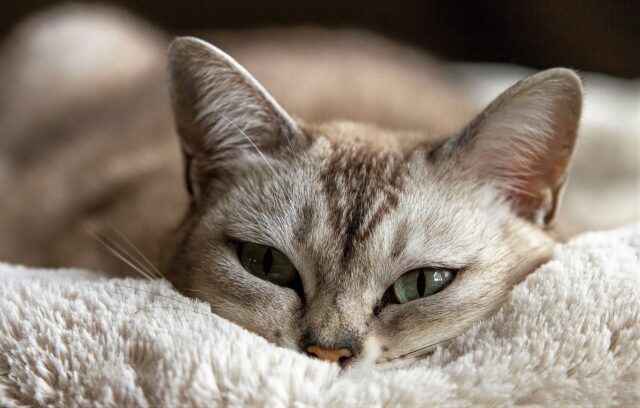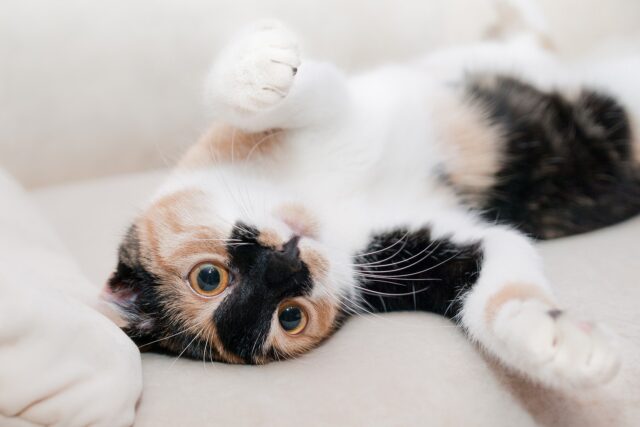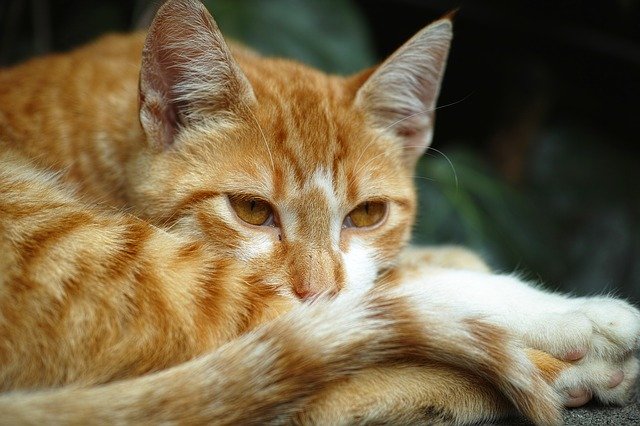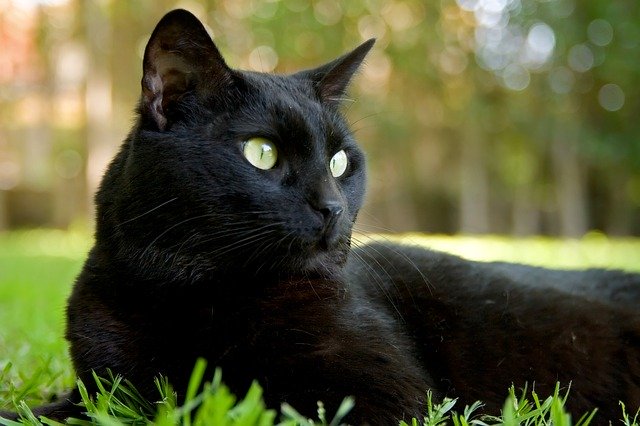Cats speak a language all their own, and while communicating with your cat can be tricky, learning their lexicon of meows, body language, and purr power will improve conversations with your kitty love.
And the more you understand each other, the tighter the bond between you and your cat will be.
Take a look at these simple ways of communicating with your cat in their language. Your furball will thank you, and you’ll know exactly what he’s telling you.
Communicating with Your Cat
1. Don’t Stare – Your Cat Finds It Rude
Cats stare for lots of reasons. They stare off into space, lost in their kitty thoughts. They stare at things they want to catch. When a food bowl is not full enough, your cat will stare you down too. But these focused gazes come with curious, but normal-sized pupils. If those pupils swell and the stare becomes intense though, somebody furry is not happy.
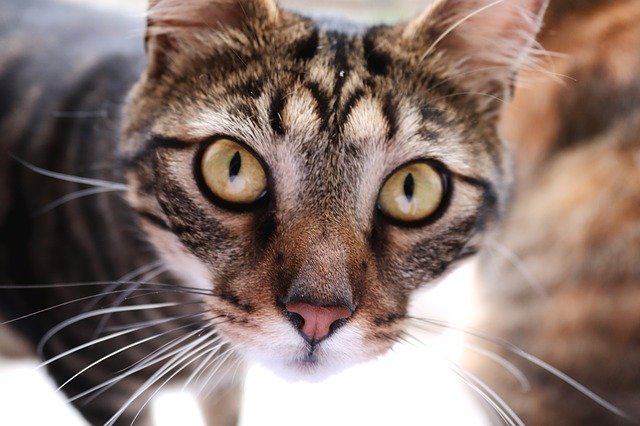
Don’t confuse your cat with a direct stare.
Cats don’t care for unblinking, direct eye contact with anyone. In the wild world, staring at another animal with unblinking eyes signals threatening intent. So, cats can take our intense stares the wrong way, thinking we’re telling them we have an issue.
As we spend more time with our cats, though, we begin to understand each other’s cues better. What might be once interpreted as a battle stare becomes just the usual between a cat and her family.
2. Slow Blinks for Your Kitty Love
While your cat doesn’t care for outright staring, he might tell you how he feels with a long, slow blink. If your kitty has given you this dreamy eye contact, he’s telling you he loves you!
Jackson Galaxy points out cats are predatory creatures who keep their eyes wide open looking for threats, and their idea of love is different from ours.
On his blog, the Cat Daddy writes, “A true way of telling said being that they are special is by letting down their ever-present guard. So, the emotion of ‘I love you,’ that we are looking for will look more like ‘I’m vulnerable to you.'”

Slow blinks are a show of affection.
And one way to show their vulnerability/love is that luxuriously slow blink. Closing out the world for that long shows how much your cat really digs you. One of the best ways to communicate with your cat is returning that slow blink.
If you’re worried about getting the blink wrong and angering your furry darling, check out Jackson’s tips on how to slow blink at your cat.
3. Chat with Your Cat
Cat lovers aren’t shy about talking to their kitties. In fact, chats with our cats are some of our favorite talks! And our cats like to answer our chatter with sweet trills and meows to keep the conversation going. But did you know a cat’s vocal range sits almost two octaves higher than human pitch?
So maybe cats do enjoy all the lovey-dovey baby talk, because, let’s be honest, we can’t help tending to pitch our voices higher when cooing at our kitties.

Communicating with your cat in high octaves is pleasing to felines.
Cats also hear in higher octaves than us too. Dr. Uri Burstyn explains cats are hunters with ears tuned to hear prey like birds and small mammals, which make high chirps and squeaks. Knowing this information, the Vancouver veterinarian performed a study of cats and their response to hearing their name spoken in higher and lower octaves. It turns out, cats are far more responsive when their names are spoken in high-pitched voices and ended with a long ‘ee’ sound.
So, go ahead with the baby talk! Communicating with your cat by giving them your best soprano will likely produce better conversation between you and your cat. And don’t we know, cats have a lot to say.
4. Cat Tummies are Off-Limits
It’s a rare cat that enjoys a belly rub, and just because a cat goes tummy up in your presence doesn’t mean she’s asking for some scratching. Nope, kitties roll over and show their furry tums when they feel secure with you.
Dr. Natalie Waggener of South Boston Animal Hospital reports cats don’t care for belly rubs as “their sensitive organs are located near their soft underbellies.”
Makes sense, we don’t like our stomachs poked either.
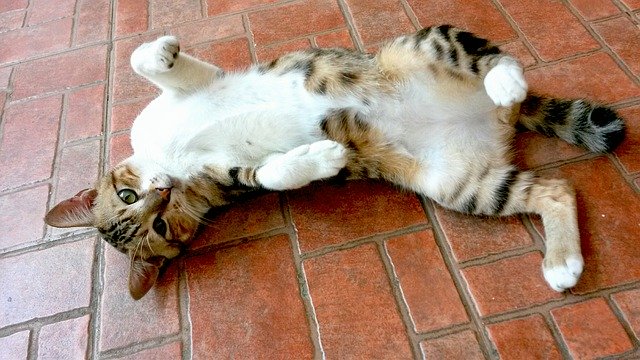
Hands off, human! No belly rubs, please!
Even though that soft fluff looks irresistible to the touch, don’t betray trust by putting hands on the belly when a cat doesn’t like it.
5. Respect the Power of the Purr
The science behind purring hasn’t been completely unlocked yet, but we’re learning more and more with advancements in technology. Cat lovers know too that everyone who hears a cat’s purr benefits. Cats purr not only for their health and ours but because they’re a happy critter!
Purring develops as a bonding mechanism between kitten and mother, and the extreme sense of comfort that arises in these earliest moments of cat’s life continues throughout life. And while purring is a common way for a cat to communicate pleasure, kitties also turn on the rumbles when sick or injured. Beyond serving as a way to calm themselves, the power of a cat’s purr can help to heal and quiet pain.
Dr. Elizabeth Von Muggenthaler terms purring as a “natural healing mechanism” for cats.
“It is suggested that purring be stimulated as much as possible when cats are ill or under duress. If purring is a healing mechanism, it may just help them to recover faster, and perhaps could even save their life,” reports Dr. Von Muggenthaler.

Purring is pleasing for cats and humans.
The next time you’re cuddling your cat and you hear kitty’s deep rumble of contentment, thank him for the soothing magic of his purr. It’s good for both of you!
6. You Need to Let Them Knead
Many cat lovers are familiar with cats’ making biscuits’ on their laps and cute as this sounds, it can be a little painful thanks to those predator claws. But cat parents often bear the pain of their cat’s kneading because this action signals their kitty is comfy and happy. And those busy paws got their start in kittenhood.
The repeated flexing of paws, known as kneading, is performed by kittens when nursing from their mothers. The action helps milk flow from a nipple, and in this moment of filling their tummy, a feline baby feels comfortable and safe. As cats grow up, they often still hold onto the kneading behavior to display their absolute contentment.
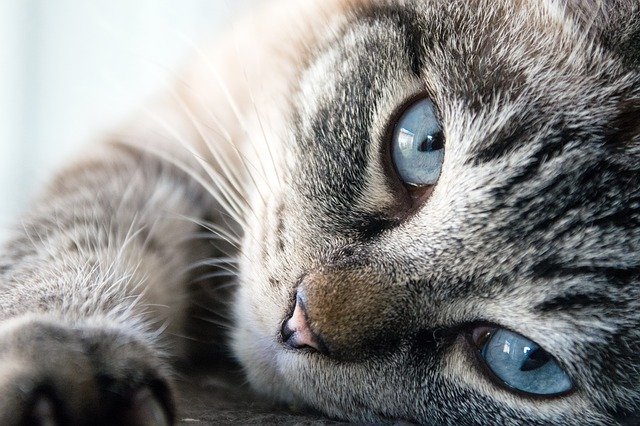
When your cat starts sinking his claws deep, it means he’s secure and happy as can be. Though the claw contact might be uncomfortable, allowing the rhythmic paw action communicates your acceptance of a kitty’s affection.
Sliding a blanket between your skin and cat claws will help minimize puncturing. Keeping kitty’s nails trimmed will too. Scratching posts also aid in maintaining claws from growing too terribly sharp. These easy ideas will keep everybody pain-free during snuggle time.
7. Bumping Heads for Hugs
Don’t you just love when your cat bumps your head with hers? As a devoted cat parent, the snuggles and purrs that come with the head butt are enough to make a heart melt with joy. You should know your cat is feeling the love too!
Pam Johnson-Bennett, author and cat behaviorist, writes, “When [your cat] comes up to you, lowers his head, and seems to butt it gently (or sometimes not so gently) right in your face he may be doing what is referred to as bunting.”
“This is a very affectionate behavior that is displayed only toward another companion animal or human family member. Bunting is a very respectful way that a cat shows affection.”
By offering your head or initiating the bump, you’re telling a kitty you understand their language, and you feel the same love they do. Communicating with your cat through head bumping is a great way to tell your cat how much you love them.
8. Listening to Tail Talk
Cat tails tell the story of a feline’s mood, and the more we know about what those whips and wags mean, the better we can understand what our cats are communicating. For example, knowing your cat’s tail cues can help you respect kitty’s space when they say space is needed through an agitated back and forth lash of the tail. Recognizing a cat’s ill mood can save you and your kitty from having an argument where they use teeth or claws.
Just because you don’t speak tail language, doesn’t mean you can’t understand it. Become fluent in tail swish with Wedgewood Pharmacy’s guide to cat tail meanings. Our aim as devoted cat parents is to keep our cat’s tail up and hooked at the tip!
9. Pay Attention to Cat Cues
Above all else, communicating with your cat comes down to really knowing him or her. While cat lovers do their best to recognize cat language, every cat speaks with their own accent.
As a cat mom or dad, you know your feline baby better than anyone. Learn their cues, and when things don’t seem right, its time to sit down and have a serious conversation. After all, our goal is to keep our cats healthy and happy their whole lives!

